
Welwitschia is a monotypic gymnosperm genus, comprising solely the distinctive Welwitschia mirabilis, endemic to the Namib desert within Namibia and Angola. The plant is commonly known simply as welwitschia in English, but the name tree tumbo is also used. It is called kharos or khurub in Nama, tweeblaarkanniedood in Afrikaans, nyanka in Damara, and onyanga in Herero. Welwitschia is the only living genus of the family Welwitschiaceae and order Welwitschiales in the division Gnetophyta, which contains three genera altogether. Informal sources commonly refer to the plant as a "living fossil".
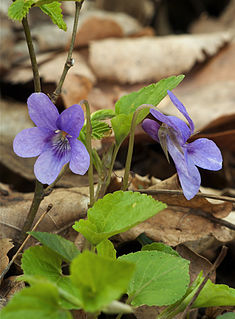
Viola is a genus of flowering plants in the violet family Violaceae. It is the largest genus in the family, containing between 525 and 600 species. Most species are found in the temperate Northern Hemisphere; however, some are also found in widely divergent areas such as Hawaii, Australasia, and the Andes.

Mirabilis is a genus of plants in the family Nyctaginaceae known as the four-o'clocks or umbrellaworts. The best known species may be Mirabilis jalapa, the plant most commonly called four o'clock.

Mirabilis jalapa, the marvel of Peru or four o'clock flower, is the most commonly grown ornamental species of Mirabilis plant, and is available in a range of colours. Mirabilis in Latin means wonderful and Jalapa is the state capital of Veracruz in México. Mirabilis jalapa was cultivated by the Aztecs for medicinal and ornamental purposes.

Nepenthes mirabilis, or the common swamp pitcher-plant and tropical pitcher plant, is a carnivorous plant species. By far the most widespread of all Nepenthes, its range covers continental Southeast Asia and all major islands of the Malay Archipelago, stretching from China in the north to Australia in the south. The species exhibits great variability throughout its range. One of the more notable varieties, N. mirabilis var. echinostoma, is endemic to Brunei and Sarawak and possesses an extremely wide peristome.

Nepenthes rowaniae is a species of pitcher plant endemic to the Cape York Peninsula, Australia. It is closely related to N. mirabilis and was once considered an extreme form of this species.
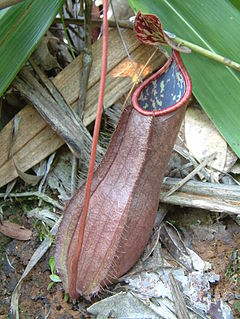
Nepenthes tomoriana is a species of pitcher plant endemic to Sulawesi, where it grows at an elevation of 0–500 m above sea level.

Nepenthes beccariana is a tropical pitcher plant. The species was described in 1908 by John Muirhead Macfarlane based on a specimen collected from the island of Nias, which lies off the western coast of Sumatra. It appears to be closely related to both N. longifolia and N. sumatrana, and the former is possibly a heterotypic synonym of this taxon.

Nepenthes smilesii is a tropical pitcher plant native to northeastern Thailand, southern Laos, Cambodia, and Vietnam. Nepenthes smilesii can tolerate an extended dry season and is most common in open, sandy savannah and grassland.

Viola sororia, known commonly as the common blue violet, is a short-stemmed herbaceous perennial plant that is native to eastern North America. It is known by a number of common names, including common meadow violet, purple violet, woolly blue violet, hooded violet, and wood violet. Its cultivar 'Albiflora' has gained the Royal Horticultural Society's Award of Garden Merit.
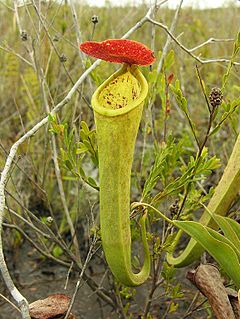
Nepenthes tenax is a lowland species of tropical pitcher plant native to northern Queensland, Australia. It is the third Nepenthes species recorded from the continent and its second endemic species. Nepenthes tenax is closely related to the two other Australian Nepenthes species: N. mirabilis and N. rowaniae.
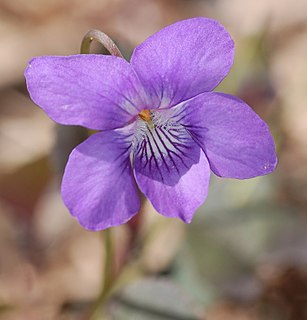
Viola labradorica, commonly known as alpine violet, American dog violet, dog violet, and Labrador violet, is a perennial. It is native to Greenland, eastern Canada, and the eastern United States. The plant sold as Viola labradorica by nurseries is Viola riviniana.

Nepenthes kongkandana is a tropical pitcher plant endemic to Songkhla Province in southern Thailand. It is closely related to N. kerrii.

Pitcher Plants of the Old World is a two-volume monograph by Stewart McPherson on the pitcher plants of the genera Nepenthes and Cephalotus. It was published in May 2009 by Redfern Natural History Productions and covers all species known at the time. The work was edited by Alastair Robinson and Andreas Fleischmann.
Eucrosia mirabilis is a species of plant from Ecuador. In the original scientific description in 1869, it was believed to be from Peru, but there is little evidence it ever grew there. The plant disappeared from cultivation until it was found in Ecuador in 1997. Its natural habitats are seasonally dry lowland areas to elevations of 1500 m.

Haworthia mirabilis is a species of the genus Haworthia belonging to the family Asphodelaceae.

Deeringia is a genus of flowering plants in the amaranth family Amaranthaceae. Its native range is tropical Asia, western Pacific, Australia and Madagascar.
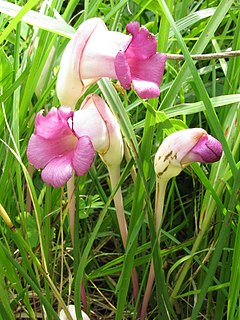
Aeginetia is a genus of plants in the broomrape family Orobanchaceae, native mostly to tropical Asia.

















